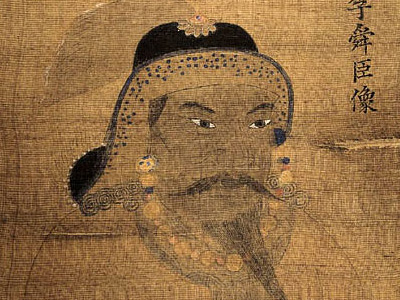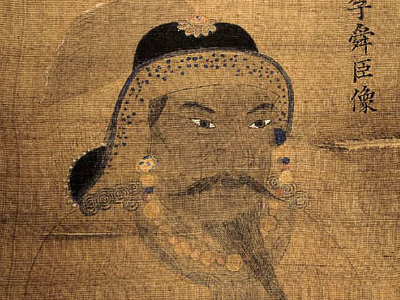Yi Sun-Shin 이순신 (1545-1598)

Turtle Ships
One of Yi's greatest accomplishments was resurrecting and improving the turtle ship (거북선; 龜船). With his creative mind and the support of his subordinates, Yi was able to devise the geobukseon, or Turtle Ship. Contrary to popular belief, the turtle ship was not actually invented by Admiral Yi; rather, he improved upon an older design that had been suggested during the reign of King Taejong.
The turtle ships designed by Yi held eleven cannons on each side of the ship, with two each at the stern and the bow. The ship's figurehead was in the shape of a dragon. The figurehead itself held up to four cannons, and emitted a smokescreen that, in combination with its fierce appearance, was meant to be used as psychological warfare. The sides of the turtle ship were dotted with smaller holes from which arrows, guns, and mortars could be fired. The roof was covered with planks and spikes. The purpose of the spikes was to prevent the ship from being boarded by the enemy. The larger Japanese ships' sides were higher than the turtle ships' and thus, the spikes prevented boarders from jumping down onto the roof without risking impalement. There were two masts that held two large sails. The turtle ship was also steered and powered by twenty oars, each of which were pulled by two men during fair conditions and five in foul seas or combat.
There is an ongoing debate as to whether the turtle ship had two decks or three; historians still have no definitive answer. Whichever is the case, it is clear that the turtle ship employed multiple decks to separate the rowers from the combat compartment. This enabled the turtle ship to be very mobile since wind and manpower could be used simultaneously. Most support the argument of two decks since that was what was drawn out in the first and second designs of the turtle ships. Some historians maintain that, since Yi was a unique individual and often pursued innovative ideas (contrary to the established wisdom of his peers), it is possible that he had the turtle ship built with three decks. It is known that his flagship, a panokseon, had three decks during his campaigns, so there is support for the belief that the turtle ship had three decks.
Turtle ships are the most famous part of Admiral Yi's fleet; however, he never deployed more than five in any one battle. The Joseon Dynasty used cannons as its primary offensive naval weapon. Historically, they had often used guns and cannons against Japanese pirates as early as the 1390s. The Joseon navy did not implement the ship-boarding strategy that the Japanese navy did, so it was imperative that their warships "stand off" from Japanese vessels. Admiral Yi made it a strategic priority to avoid hand-to-hand combat, in which the Japanese navy specialized. The turtle ship was developed to support his tactic against Japanese fleets.
Turtle ships were first used in the Battle of Sacheon (1592) and were used in nearly every battle until the devastating Battle of Chilchonryang, when a Japanese double-agent plot nearly succeeded, resulting in every turtle ship and all but 13 panokseon being sunk. The turtle ships did not re-appear in battle until the Battle of Noryang.
Turtle ships were mostly used to spearhead attacks. They were best used in tight areas and around islands rather than the open sea.
HISTORY

RESOURCES
This article uses material from the Wikipedia article "Yi Sun-Shin", which is released under the Creative Commons Attribution-Share-Alike License 3.0.
© Stories Preschool. All Rights Reserved.











